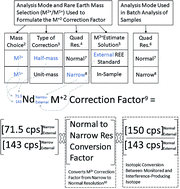当前位置:
X-MOL 学术
›
J. Anal. At. Spectrom.
›
论文详情
Our official English website, www.x-mol.net, welcomes your feedback! (Note: you will need to create a separate account there.)
Analytical considerations associated with implementing M2+ correction factors to address false positives on As and Se within U.S. EPA method 200.8†‡
Journal of Analytical Atomic Spectrometry ( IF 3.4 ) Pub Date : 2019-08-27 , DOI: 10.1039/c9ja00086k Skyler W. Smith 1, 2, 3, 4, 5 , Nicole Hanks 4, 5, 6, 7, 8 , Patricia A. Creed 4, 5, 7, 8 , Kasey Kovalcik 5, 7, 8, 9 , Robert A. Wilson 4, 5, 10, 11 , Kevin Kubachka 4, 5, 10, 11 , Judith A. Brisbin 4, 5, 7, 12 , Julio Landero Figueroa 3, 4, 5, 13 , John T. Creed 4, 5, 7, 8
Journal of Analytical Atomic Spectrometry ( IF 3.4 ) Pub Date : 2019-08-27 , DOI: 10.1039/c9ja00086k Skyler W. Smith 1, 2, 3, 4, 5 , Nicole Hanks 4, 5, 6, 7, 8 , Patricia A. Creed 4, 5, 7, 8 , Kasey Kovalcik 5, 7, 8, 9 , Robert A. Wilson 4, 5, 10, 11 , Kevin Kubachka 4, 5, 10, 11 , Judith A. Brisbin 4, 5, 7, 12 , Julio Landero Figueroa 3, 4, 5, 13 , John T. Creed 4, 5, 7, 8
Affiliation

|
Rare earth elements (REE) can produce M2+ ions in ICP-MS and 150Nd2+, 150Sm2+, and 156Gd2+ can produce false positives on 75As and 78Se. Alternative instrumental tuning conditions, that utilize lower He flows within the collision cell, reduce these false positives by a factor of 2 (to 0.8 ppb As and 19 ppb Se in solutions containing 50 ppb Nd and Gd) with comparable 16O35Cl+ reduction (<100 ppt false 51V in 0.4% HCl) and Se sensitivity (DL < 1 ppb). Further reduction of these false positives is achieved by estimating the M2+ correction factors and utilizing them in the interference-correction software. Approaches to estimating the M2+ correction factor were evaluated with an emphasis on techniques that tolerate daily variability in end-user backgrounds and their ability to reduce the initial and ongoing purity requirements associated with the rare earth standards used to estimate the M2+ correction factor. The direct elemental and polyatomic overlaps associated with unit-mass approaches tend to overcorrect as non-rare-earth signals as small as 30 cps at the unit mass can induce bias relative to the <300 cps signals associated with the M2+ from a 50 ppb REE standard solution. Alternatively, shifting the M2+ estimate to a half mass (i.e., m/z 71.5: 143Nd2+) eliminates the direct overlap source of bias and allows the unit mass signal to approach 150 000 cps before it bleeds over on the 1/2 mass because of abundance sensitivity limitations. The performance of the half-mass approach was evaluated in reagent water and regional tap waters fortified with Nd, Sm, and Gd at 2 ppb and 50 ppb. In addition, a half-mass in-sample approach was also evaluated. This approach was found to be beneficial relative to the external or fixed-factor half-mass approach as it could compensate for instrument drift and matrix-induced shifts in the M2+ factors. Finally, all results were evaluated relative to the As and Se concentrations determined using an ICP-QQQ in mass shift mode and a high-resolution ICP-MS.
中文翻译:

与实施中号相关的分析考虑2+美国EPA方法200.8内校正因子,以解决砷和硒误报† ‡
稀土元素(REE)可以在ICP-MS中产生M 2+离子,而150 Nd 2 +,150 Sm 2+和156 Gd 2+可以在75 As和78 Se上产生假阳性。利用碰撞池中较低He流量的替代仪器调节条件,可将这些误报减少2倍(在含有50 ppb Nd和Gd的溶液中降至0.8 ppb As和19 ppb Se),且还原度可比16 O 35 Cl +(<100 ppt错误51V在0.4%HCl中)和Se敏感性(DL <1 ppb)。通过估计M 2+校正因子并在干扰校正软件中使用它们,可以进一步减少这些误报。对M 2+校正因子的估算方法进行了评估,重点是耐受最终用户背景中每日变化的技术及其降低与用于估算M 2+校正的稀土标准品相关的初始和正在进行的纯度要求的能力因素。与单位质量方法相关的直接元素和多原子交叠往往会过度校正,因为单位质量的30 cps的非稀土信号相对于与M 2+相关的<300 cps信号会产生偏差。来自50 ppb REE标准溶液。可替代地,M个移位2+估计到一半的质量(即,米/ ž 71.5:143的Nd 2+)消除了偏置的直接重叠源,并且由于丰度灵敏度限制,允许单位质量信号在其流失超过1/2质量之前接近150 000 cps。在试剂水和以2 ppb和50 ppb的Nd,Sm和Gd强化的区域自来水中,评估了半质量方法的性能。此外,还评估了半质量样品方法。发现该方法相对于外部或固定因子半质量方法是有益的,因为它可以补偿仪器漂移和矩阵引起的M 2+因子漂移。最后,对所有结果进行了相对于使用质量转移模式下的ICP-MS / MS和高分辨率ICP-MS测定的As和Se浓度的评估。
更新日期:2019-11-01
中文翻译:

与实施中号相关的分析考虑2+美国EPA方法200.8内校正因子,以解决砷和硒误报† ‡
稀土元素(REE)可以在ICP-MS中产生M 2+离子,而150 Nd 2 +,150 Sm 2+和156 Gd 2+可以在75 As和78 Se上产生假阳性。利用碰撞池中较低He流量的替代仪器调节条件,可将这些误报减少2倍(在含有50 ppb Nd和Gd的溶液中降至0.8 ppb As和19 ppb Se),且还原度可比16 O 35 Cl +(<100 ppt错误51V在0.4%HCl中)和Se敏感性(DL <1 ppb)。通过估计M 2+校正因子并在干扰校正软件中使用它们,可以进一步减少这些误报。对M 2+校正因子的估算方法进行了评估,重点是耐受最终用户背景中每日变化的技术及其降低与用于估算M 2+校正的稀土标准品相关的初始和正在进行的纯度要求的能力因素。与单位质量方法相关的直接元素和多原子交叠往往会过度校正,因为单位质量的30 cps的非稀土信号相对于与M 2+相关的<300 cps信号会产生偏差。来自50 ppb REE标准溶液。可替代地,M个移位2+估计到一半的质量(即,米/ ž 71.5:143的Nd 2+)消除了偏置的直接重叠源,并且由于丰度灵敏度限制,允许单位质量信号在其流失超过1/2质量之前接近150 000 cps。在试剂水和以2 ppb和50 ppb的Nd,Sm和Gd强化的区域自来水中,评估了半质量方法的性能。此外,还评估了半质量样品方法。发现该方法相对于外部或固定因子半质量方法是有益的,因为它可以补偿仪器漂移和矩阵引起的M 2+因子漂移。最后,对所有结果进行了相对于使用质量转移模式下的ICP-MS / MS和高分辨率ICP-MS测定的As和Se浓度的评估。



























 京公网安备 11010802027423号
京公网安备 11010802027423号